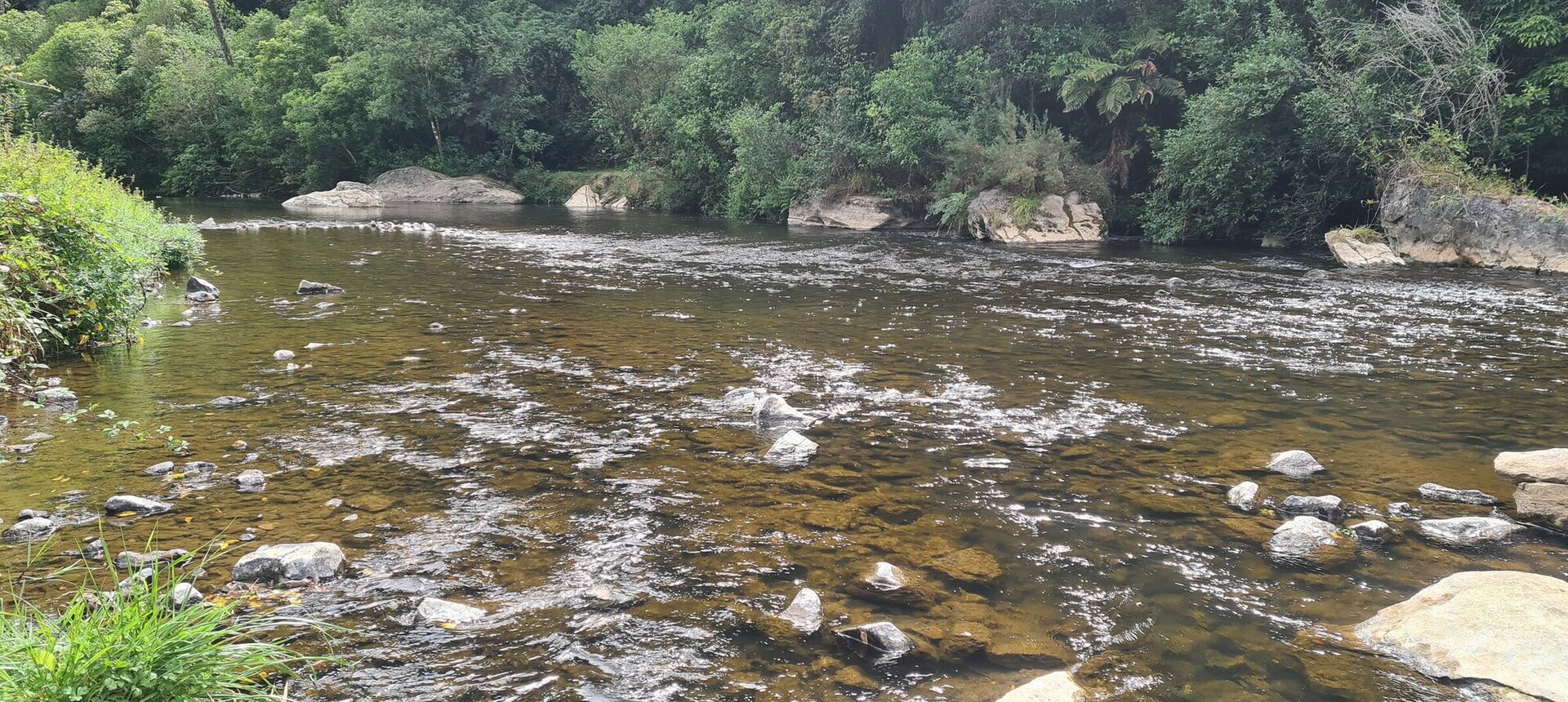2025 Quarterly Summaries
August 2025
Water quality was Fair in Mangaokewa stream-viaduct (Site 4) and Waiteti stream-upper (Site 46), and Poor in Mangawhauwhi stream (Site 5) and Waiteti stream-viaduct (Site 6).
E. coli concentrations were very low in three sites (≤ 100 cells per 100 mL) and slightly elevated in Waiteti stream-viaduct (270 cells per 100 mL). All sites met recommended health guidelines for swimming (540 cells per 100 mL) and Mangawhauwhi stream and Waiteti stream-upper also met guidelines for livestock drinking water (< 100 cells per 100 mL) [1].
Nitrogen:
Nitrate concentrations were low in Waiteti stream-upper (0.33 mg/L) and slightly elevated across the other three sites, exceeding Waikato Plan Change One targets (0.525 mg/L). Though all sites fell well below ecological toxicity levels (2.4 mg/L).
Ammonia concentrations were very low at two sites, Mangaokewa stream and Waiteti stream-upper (< 0.005 mg/L) and slightly higher at Mangawhauwhi stream and Waiteti stream (0.006 – 0.01 mg/L) posing a low risk to aquatic life but exceeded Plan Change One targets (0.005 mg/L).
Dissolved inorganic nitrogen (DIN) was low in Waiteti stream-upper (0.33 mg/L), slightly elevated in Mangaokewa stream (0.84 mg/L) and Waiteti stream-viaduct (0.73 mg/L) and elevated in Mangawhauwhi stream (1.11 mg/L). Consequently, three quarters of all sites exceeding the ecological impact threshold (0.5 mg/L).Phosphorus:
Dissolved reactive phosphorus (DRP) concentrations were low across all sites (≤ 0.010 mg/L).Suspended sediment/Water Clarity:
Water clarity was Fair in Mangaokewa stream (1.52 m) and Poor across all other sites (≤ 1.17 m), relative to the national bottom line (1.34 m).
The results in the table below have been graded according to the National Policy Statement for Freshwater Management (NPS-FM, 2020) and Waikato Plan Change One (PC1, 2020), using the strictest applicable measure.
[1] Drinking water for livestock should contain < 100 cfu/100 mL (median value) of E. coli. Livestock Drinking Water Guidelines (2023), Australian & New Zealand Guidelines for Fresh & Marine Water Quality.
Sample Collection Day: 25th August 2025

May 2025
Water quality was Fair in Waiteti stream-viaduct (Site 6) and Waiteti stream-upper (Site 46), and Poor in Mangaokewa stream-viaduct (Site 4), Mangawhauwhi stream (Site 5).
E. coli concentrations were low in Waiteti stream-upper (150 cells per 100 mL), slightly elevated in Mangaokewa stream (370 cells per 100 mL) and elevated in Mangawhauwhi stream (550 cells per 100 mL) and Waiteti stream-viaduct (650 cells per 100 mL), exceeding recommended health guidelines for swimming (540 cells per 100 mL).
Nitrogen:
Nitrate concentrations were low in Waiteti stream (≤ 0.38 mg/L) and moderate in Mangaokewa stream (0.52 mg/L), falling well below ecological toxicity levels (2.4 mg/L) and Waikato Plan Change One targets (0.525 mg/L). Concentrations were moderate in Mangawhauwhi stream (0.76 mg/L) exceeding Waikato, Plan Change One targets (0.525 mg/L).
Ammonia concentrations were low in all sites (≤ 0.02 mg/L), posing a low risk to aquatic life. However, all sites exceeded Plan Change One targets (0.005 mg/L).
Dissolved inorganic nitrogen (DIN) was low in Waiteti stream (≤ 0.38 mg/L), and slightly elevated in Mangaokewa stream (0.52 mg/L) and Mangawhauwhi stream (0.76 mg/L), exceeding the ecological impact threshold (0.5 mg/L).Phosphorus:
Dissolved reactive phosphorus (DRP) concentrations were low in Waiteti stream-viaduct (0.009 mg/L) and Mangawhauwhi stream (0.01 mg/L), slightly elevated in Mangaokewa stream-viaduct (0.017 mg/L) and Waiteti stream-upper (0.013 mg/L).Suspended sediment/Water Clarity: Water clarity was Excellent in Mangawhauwhi stream (2.20 m), Good in Mangawkewa stream (1.69 m) and Waiteti stream-vaiduct (1.60 m) and Fair in Waiteti stream-upper (1.52 m), relative to the national bottom line (1.34 m).
The results in the table below have been graded according to the National Policy Statement for Freshwater Management (NPS-FM, 2020) and Waikato Plan Change One (PC1, 2020), using the strictest applicable measure.
Collection date: 15th May 2025

February 2025
Water quality was Fair across all sites – Mangaokewa stream-viaduct (Site 4), Mangawhauwhi stream (Site 5), Waiteti stream-viaduct (Site 6) and Waiteti stream-upper (Site 46).
E. coli concentrations were low in Waiteti stream-upper (150 cells per 100 mL), slightly elevated in Mangaokewa stream (350 cells per 100 mL) and very high in Mangawhauwhi stream (2,000 cells per 100 mL) and Waiteti stream-viaduct (3,100 cells per 100 mL), exceeding recommended health guidelines for swimming (540 cells per 100 mL).
Nitrogen:
Nitrate concentrations were very low across all sites, falling well below ecological toxicity levels (2.4 mg/L) and Waikato, Plan Change One targets (0.525 mg/L). Mangawhauwhi stream had the lowest nitrate concentrations (0.08 mg/L) and Waiteti stream-viaduct had the highest concentrations (0.4 mg/L).
Ammonia concentrations were very low in Waiteti stream-viaduct (0.005 mg/L) and slightly higher in the other three sites, exceeding Plan Change One targets (0.005 mg/L).
Dissolved inorganic nitrogen (DIN) was also low across all sites (≤ 0.40 mg/L), falling below the ecological impact threshold (0.5 mg/L).Phosphorus:
Dissolved reactive phosphorus (DRP) concentrations were low in Waiteti stream (0.007 mg/L), slightly elevated in Mangaokewa stream-viaduct (0.012 mg/L) and Waiteti stream-upper (0.014 mg/L) and very high in Mangawhauwhi stream (0.022 mg/L).Suspended sediment/Water Clarity:
Water clarity was excellent in Mangaokewa stream and Mangawhauwhi stream (1.97 m), fair in Waiteti stream-viaduct (1.42 m) and poor Waiteti stream-upper (1.15 m), relative to the national bottom line (1.34 m).
The results in the table below have been graded according to the National Policy Statement for Freshwater Management (NPS-FM, 2020) and Waikato Plan Change One (PC1, 2020), using the strictest applicable measure.
Collection date: 18th February 2025

Water Quality Summary 2024
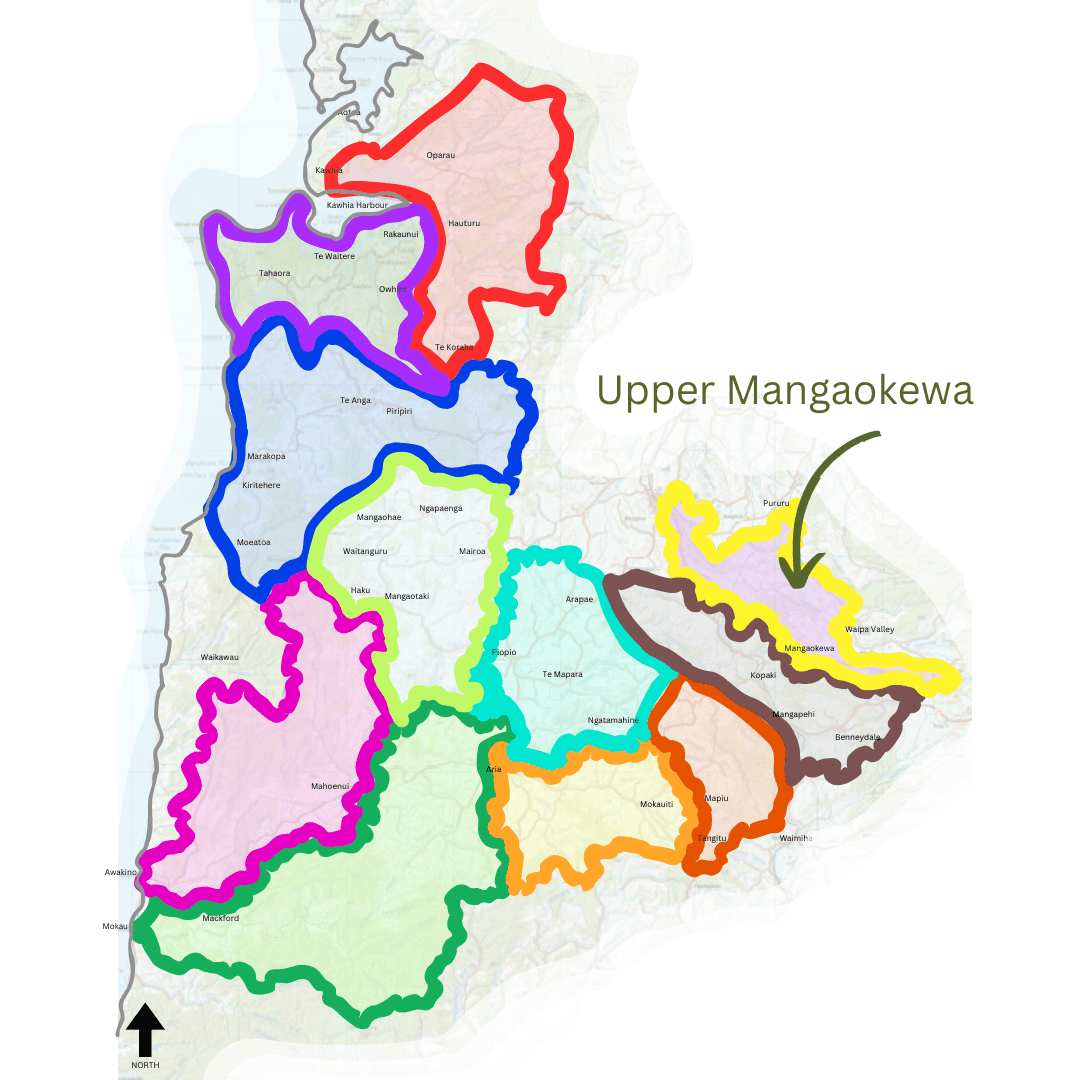
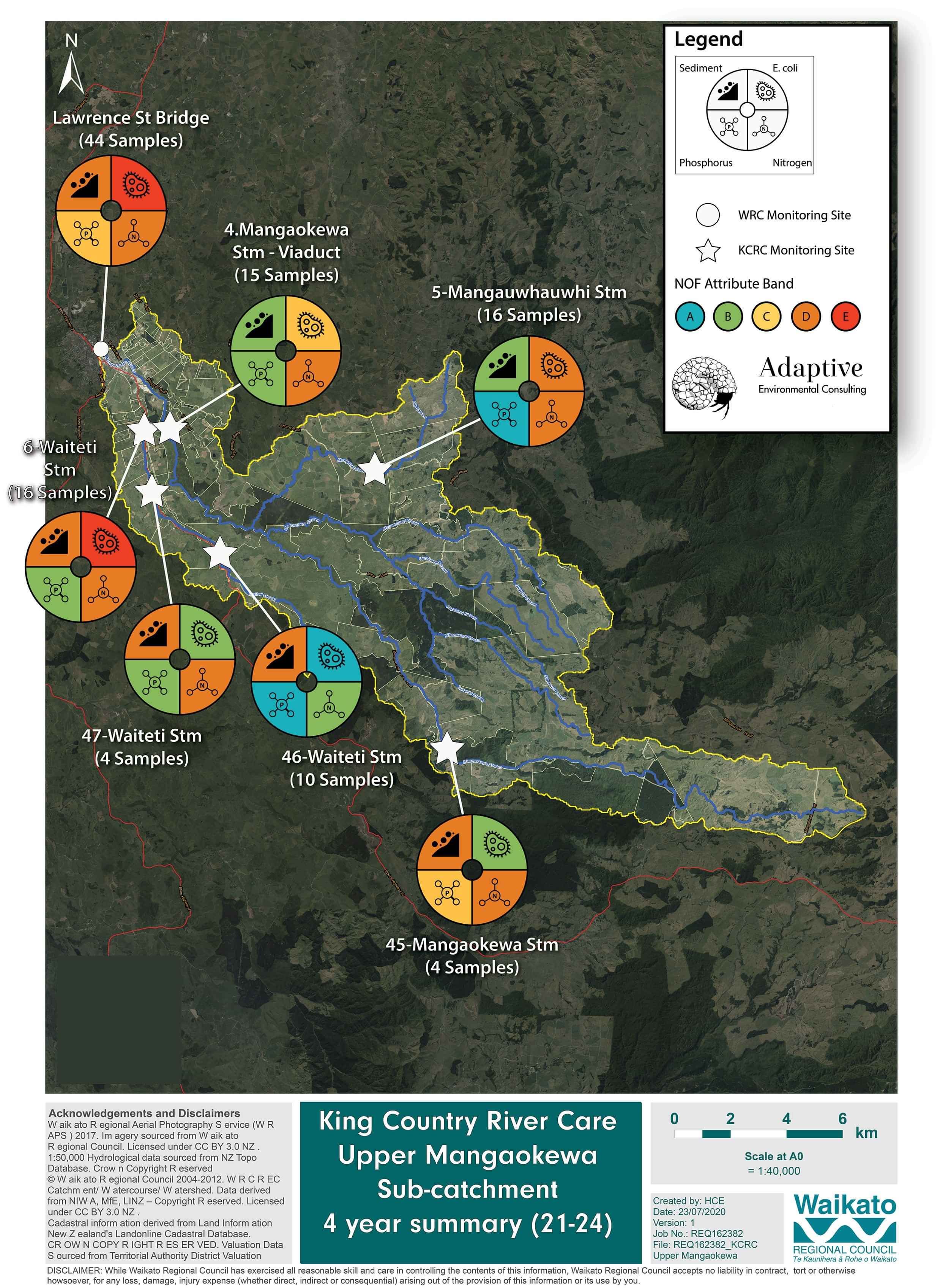
The results have been assessed against the national freshwater attribute bands under the national policy statement for freshwater (NPS-FM 2020).
The overall E. coli band is based on the following four measures, the percentage of samples exceeding 540 (CFU/100ml), the percentage of samples exceeding 260 (CFU/100ml), the median value and the 95th percentile (or upper 5% of E. coli concentrations).
The overall nitrogen band is based on the following six measures, Nitrate Toxicity (median and 95th percentile), Ammonia Toxicity (median and maximum annual value) and Dissolved Inorganic Nitrogen (median and 95th percentile).
The dials on the map below show water quality data from seven monitoring sites in the Upper Mangaokewa River catchment. Each dial reflects all data collected at the site since the KCRC monitoring programme in 2021.
Catchment monitoring by King Country River Care commenced in May 2021 and covers between 4 to 6 monitoring sites sampled on a quarterly basis. Waikato Regional Council (WRC) has one monitoring site at Lawrence St Bridge, Te Kuiti, which is monitored monthly. A water quality baseline was calculated from the time the catchment group was formed using five years (Jan 2015 – Dec 2019) of monthly monitoring data, collected at the WRC site.
2024 represents the fourth consecutive year of catchment monitoring. Water samples were collected on 14 Feb, 13 May, 22 August and 18 November, during stable weather to avoid any significant rainfall events. River flow strongly influences water quality and the river flow hydrograph for the Upper Mangaokewa River.
Key Resources Being Lost from the Land
Monitoring results show the key resources being lost from the Upper Mangaokewa catchment in 2024 were Nitrogen, Sediment (reflected by low water clarity) and E. coli. Nitrogen and Suspended Sediment were elevated in 3 out of 5 sites, while E. coli was elevated in 2 sites. Loss of Sediment and Nitrogen represents a loss of soil and nutrients, while elevated E. coli represents a loss of organic matter and nutrients as it is largely associated with animal manure in rural catchments.
The below water quality dials summarise the results collected in the Upper Mangaokewa catchment. The top dial shows the baseline for the catchment, covering 5 years of regional council monitoring at Lawrence Street Bridge in Te Kuiti. The second dial combines all data collected in 2024 at five sites, 28 samples in total. Arrows indicate either an increase or decrease in values compared to the sub-catchment baseline. Arrows indicate either an increase or decrease in values compared to the sub-catchment baseline. An increase in water clarity is positive for river health while an increase in all other indicators may impair river health.
In 2024, indicators for phosphorus and water clarity/suspended sediment met water quality limits, while Nitrogen and E. coli did not. Compared to the baseline – Water clarity was greater in 2024 and the concentration of dissolved reactive phosphorus and E. coli were lower.
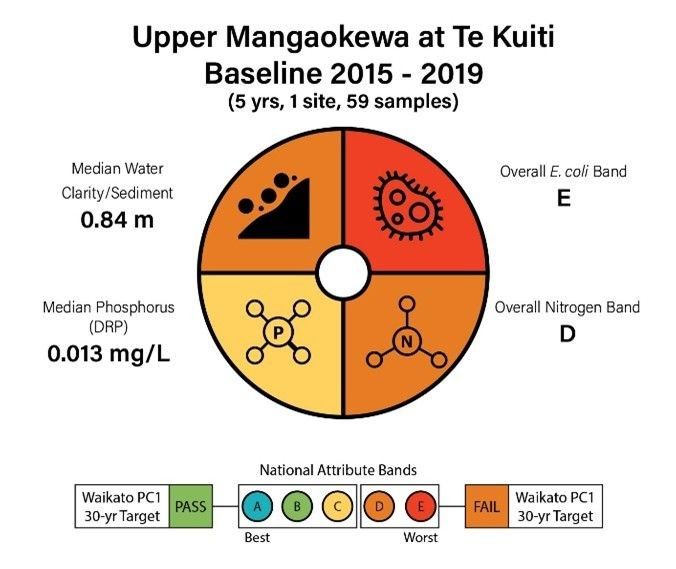
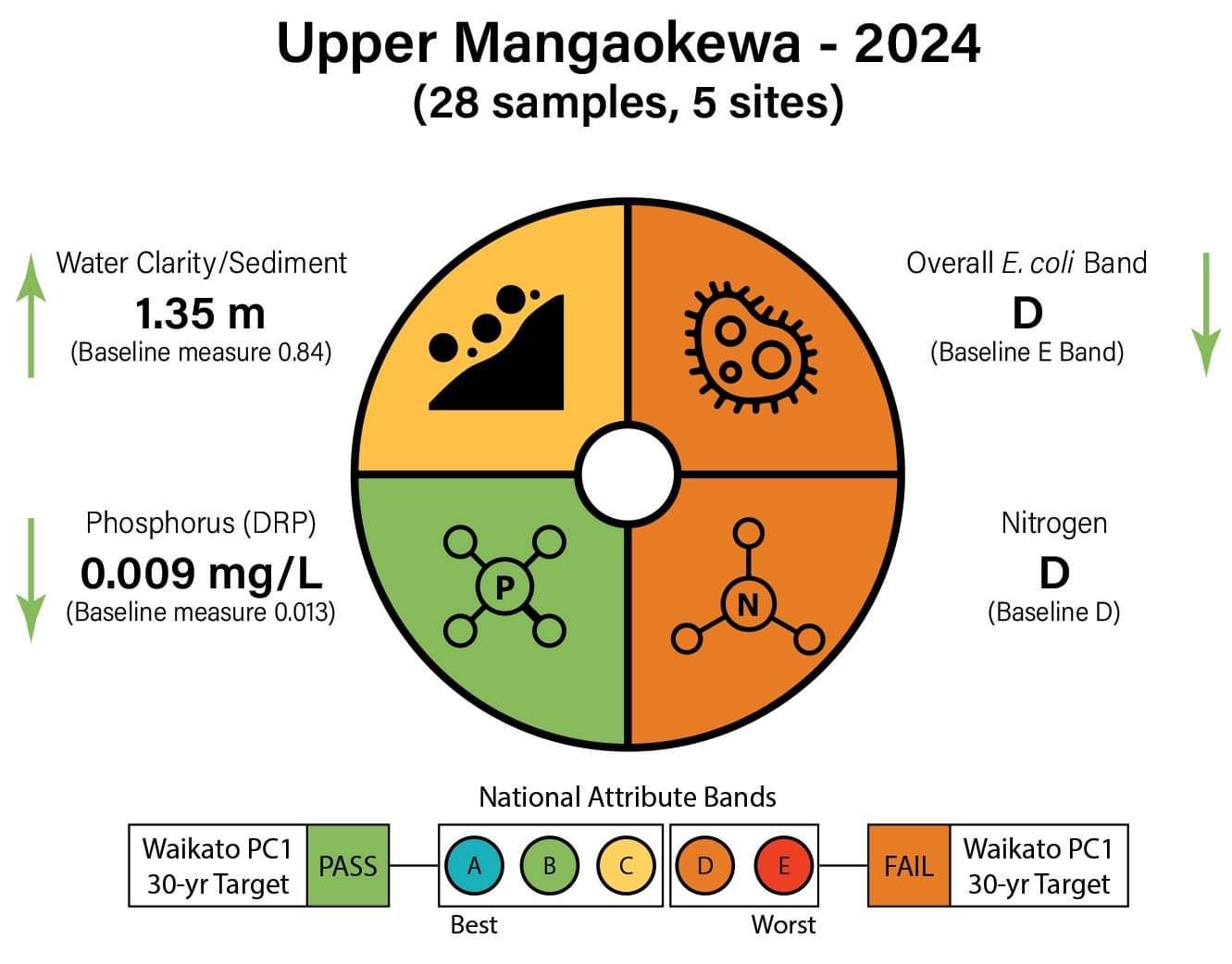
2024 Quarterly Summaries
November 2024
Water quality was Poor. E. coli was elevated at all sites, nutrients and suspended sediment were elevated at 75% of sites.
E. coli concentrations were elevated at all sites (between 320 and 690) falling above the recommending health level for swimming (540) at one site, 6-Waiteti stream (viaduct). E. coli concentrations were lowest at 4-Mangaokewa stream and highest at 6-Waiteti stream (viaduct). Nitrate concentrations exceeded regional, PC1 targets (0.525 mg/L) at two sites, 4-Mangaokewa stream and 5-Mangawhauwhi stream. However, all sites fell well below ecological toxicity levels (2.4 mg/L). Nitrates were lowest at 46-Waiteti stream-Upper (0.26 mg/L) and highest at 5-Mangawhauwhi stream (0.78 mg/L). Ammonia concentrations were low at all sites (≤ 0.01 mg/L), however, all sites exceeded PC1 targets (0.005 mg/L). Dissolved inorganic nitrogen (DIN) concentrations were low at 46-Waiteti Stream-Upper (0.27 mg/L), but were slightly elevated at the other three sites (between 0.52 and 0.79 mg/L). DIN concentrations greater than 0.5 mg/L can cause ecological impacts like excessive growth of algae and aquatic plants, and loss of sensitive species. DIN concentrations were highest at 5-Mangawhauwhi stream. Dissolved reactive phosphorus concentrations were low at all sites (≤ 0.010 mg/L). Water clarity was good at 5-Mangawhauwhi stream (1.64 m), low at 4-Mangaokewa stream (1.48 m) and poor at all the other two sites, relative to the national bottom line (1.34 m). The lowest water clarity was recorded at 6-Waiteti stream (0.68 m).
Sample Collection Date: 19th November

August 2024
Water quality was Fair. Nitrogen parameters and suspended sediment were elevated at some sites.
E. coli concentrations were very low at all sites (≤ 98), falling well within recommending health levels for swimming (540). Nitrate concentrations were low at 46-Waiteti stream-Upper (0.36 mg/L) but elevated at the other three sites, where concentrations were above regional, PC1 targets (0.525 mg/L), however, all sites fell well below ecological toxicity levels (2.4 mg/L). Nitrates were lowest at 46-Waiteti Stream-Upper (0.36 mg/L) and highest at 5-Mangawhauwhi stream (1.01 mg/L). Ammonia concentrations were low at all sites (≤ 0.02 mg/L) but exceeded PC1 targets (0.005 mg/L) at three out of four sites. Dissolved inorganic nitrogen (DIN) concentrations were low at 46-Waiteti Stream-Upper (0.37 mg/L), slightly elevated at 4-Mangaokewa stream and 6-Waiteti stream-viaduct (≥ 0.71 mg/L) and elevated at 5-Mangawhauwhi stream (1.02 mg/L). DIN concentrations greater than 0.5 mg/L can cause ecological impacts like excessive growth of algae and aquatic plants, and loss of sensitive species. Dissolved reactive phosphorus concentrations were low at all sites (≤ 0.01 mg/L). Water clarity was excellent at 5-Mangawhauwhi Stream (1.9 m), good at 4-Mangaokewa stream (1.64 m) and poor in the two Waiteti stream sites, relative to the national bottom line (1.34 m).
Sample Collection Day: 13 August 2024

May 2024
Overall water quality was Fair. Nitrogen parameters and suspended sediment were elevated at some sites.
E. coli concentrations were low at all sites (≤ 190), falling within recommending health levels for swimming (540). Nitrate concentrations were low at two sites (≤ 0.41) and elevated at 4-Mangaokewa stream and 5-Mangawhauwhi stream, where they were above regional PC1 targets (0.525 mg/L). All sites fell well below ecological toxicity levels (2.4 mg/L). Nitrates were lowest at 46-Waiteti Stream-Upper (0.15 mg/L) and highest at 4-Mangaokewa stream (0.83 mg/L). Ammonia concentrations were low at two sites (<0.005 mg/L) but exceeded PC1 targets (0.005 mg/L) at the two Waiteti stream sites. Dissolved inorganic nitrogen concentrations were low at the two Waiteti stream sites (≤0.41 mg/L) and slightly elevated at the other two sites, potentially impacting ecological health by promoting excessive growth of algae, aquatic weeds and impacting sensitive aquatic life. Dissolved reactive phosphorus concentrations were low at all sites (≤ 0.007 mg/L). Water clarity was excellent at 5-Mangawhauwhi Stream (3.13 m) and good at the two Waiteti stream sites. Water clarity was poor at 4-Mangaokewa stream (1.14 m), relative to the national bottom line (1.34 m).
Collection date: 14th May 2024 (excl. Site 4 - Mangaokewa stream sampled 20th June 2024)

February 2024
Overall water quality was Fair. E. coli, Dissolved Inorganic Nitrogen and suspended sediment were elevated at some sites.
E. coli concentrations were low at three sites (≤180) but elevated at Mangawhauwhi stream (600), above recommending health levels for swimming (540). Nitrate concentrations were low at all sites, falling below regional PC1 targets (0.525 mg/L) and well below levels where ecological toxicity impacts can occur (2.4 mg/L). Nitrates were lowest at 46-Waiteti Stream-Upper (0.07 mg/L) and highest at 6-Waiteti Stream-Viaduct (0.45 mg/L). Ammonia concentrations were low at 4-Mangaokewa Stream (viaduct) and 46-Waiteti stream (< 0.005 mg/L) but exceeded PC1 targets (0.005 mg/L) at 5-Mangawhauwhi stream and 6-Waiteti stream (≥ 0.006 mg/L). Dissolved inorganic nitrogen concentrations were low at all sites (≤ 0.46 mg/L). Dissolved reactive phosphorus concentrations were low at all sites (≤ 0.01 mg/L). Water clarity was excellent at 4-Mangaokewa Stream (2.39 m) and 6-Waiteti stream (2.78 m) but was poor at 5-Mangawhauwhi stream (1.33 m) and 46-Waiteti stream (1.17 m), relative to the national bottom line (1.34 m).
Collection date: 22nd & 28th February 2024

Water Quality Summary 2023
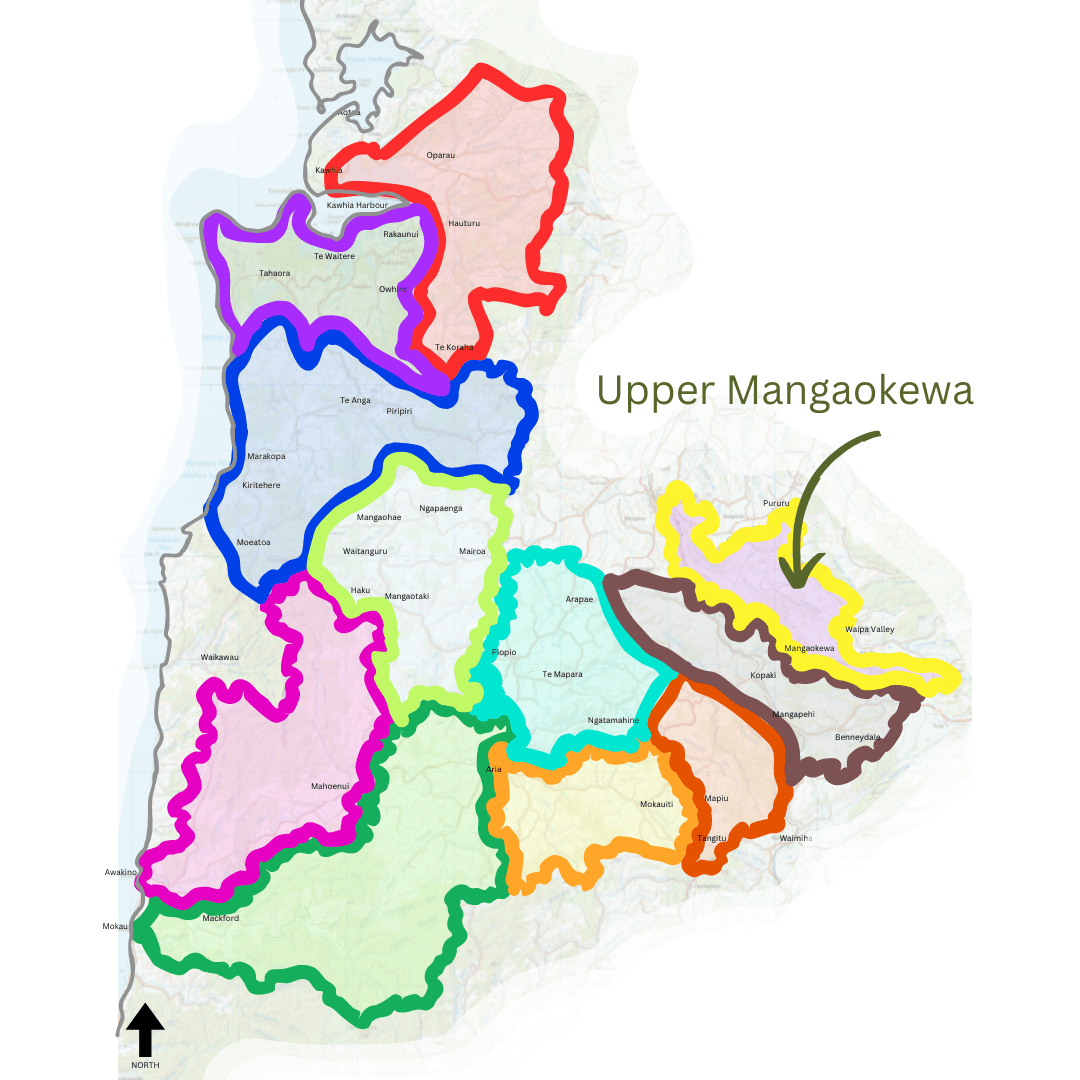
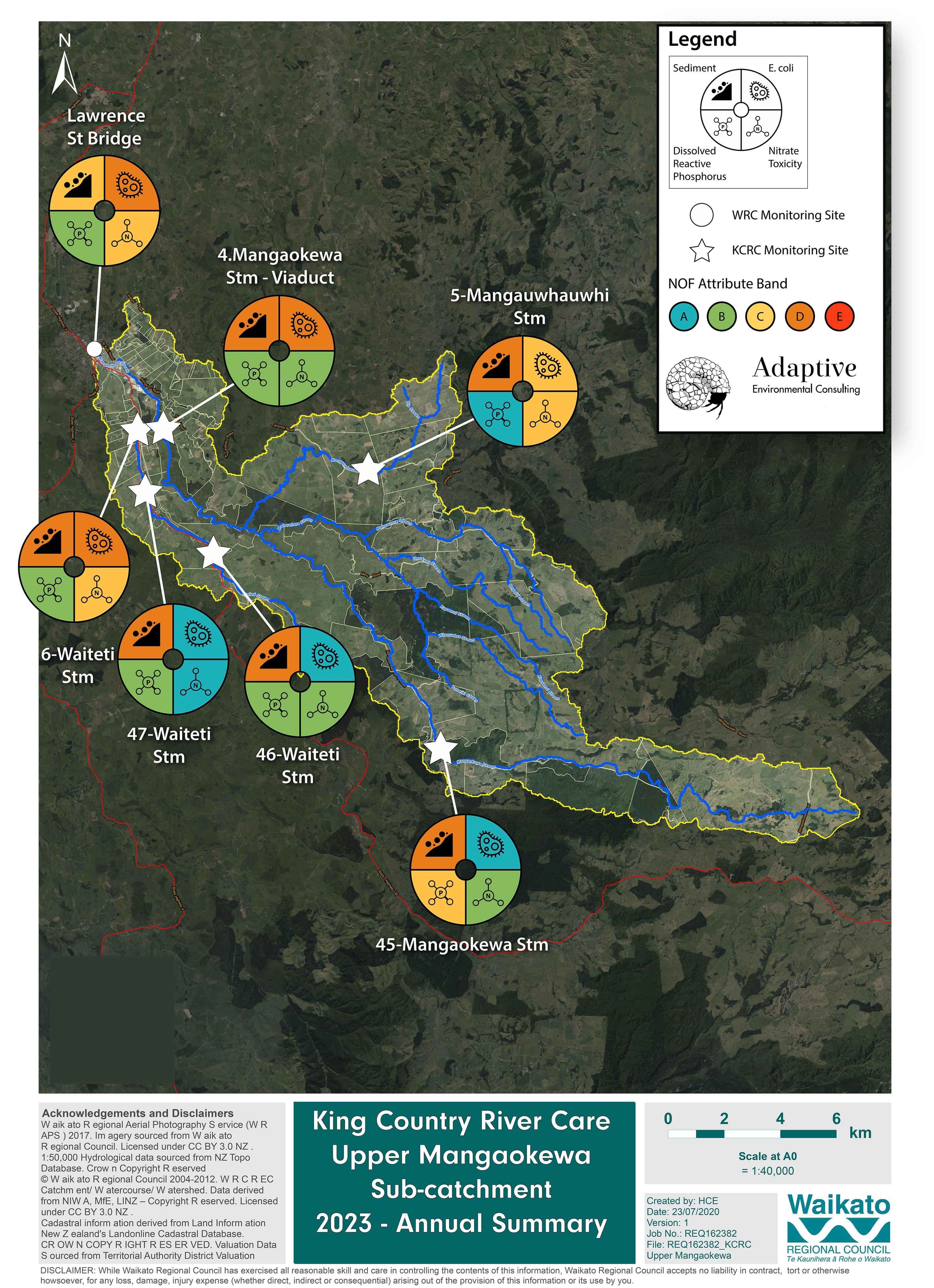
Water samples were collected from 7 stream and river sites across the Upper Mangaokewa catchment. Monitoring sites were located on Mangaokewa stream, Waiteti stream and the Mangauwhauwhi stream. The below water quality dial summarises 29 individual samples collected across 7 monitoring sites, between January 2023 and December 2023.
Water clarity was poor, indicated elevated levels of suspended sediment, which impacts aquatic life. E. coli and nitrogen were slightly elevated. Elevated Slightly E. coli can is a potential risk to human health when swimming and elevated nitrogen can impact aquatic life and river health by promoting excessive growth of algae, bacteria and aquatic weeds and decreasing dissolved oxygen levels in the water. Dissolved reactive phosphorus (DRP) was low, which supports river health. Water clarity did not meet national water quality standards, while nitrate and ammonia concentrations did not meet regional (Plan Change 1) short-term targets. Dissolved reactive phosphorus, nitrate and ammonia toxicity and E. coli did meet national standards.
Arrows indicate an increase or decrease in values compared to the baseline. The baseline was calculated from 5 years of data collected by Waikato Regional Council at Lawrence St Bridge in Te Kūiti, between 2015 and 2019. An increase in water clarity is positive for river health, while an increase in all other attributes may impair river health.
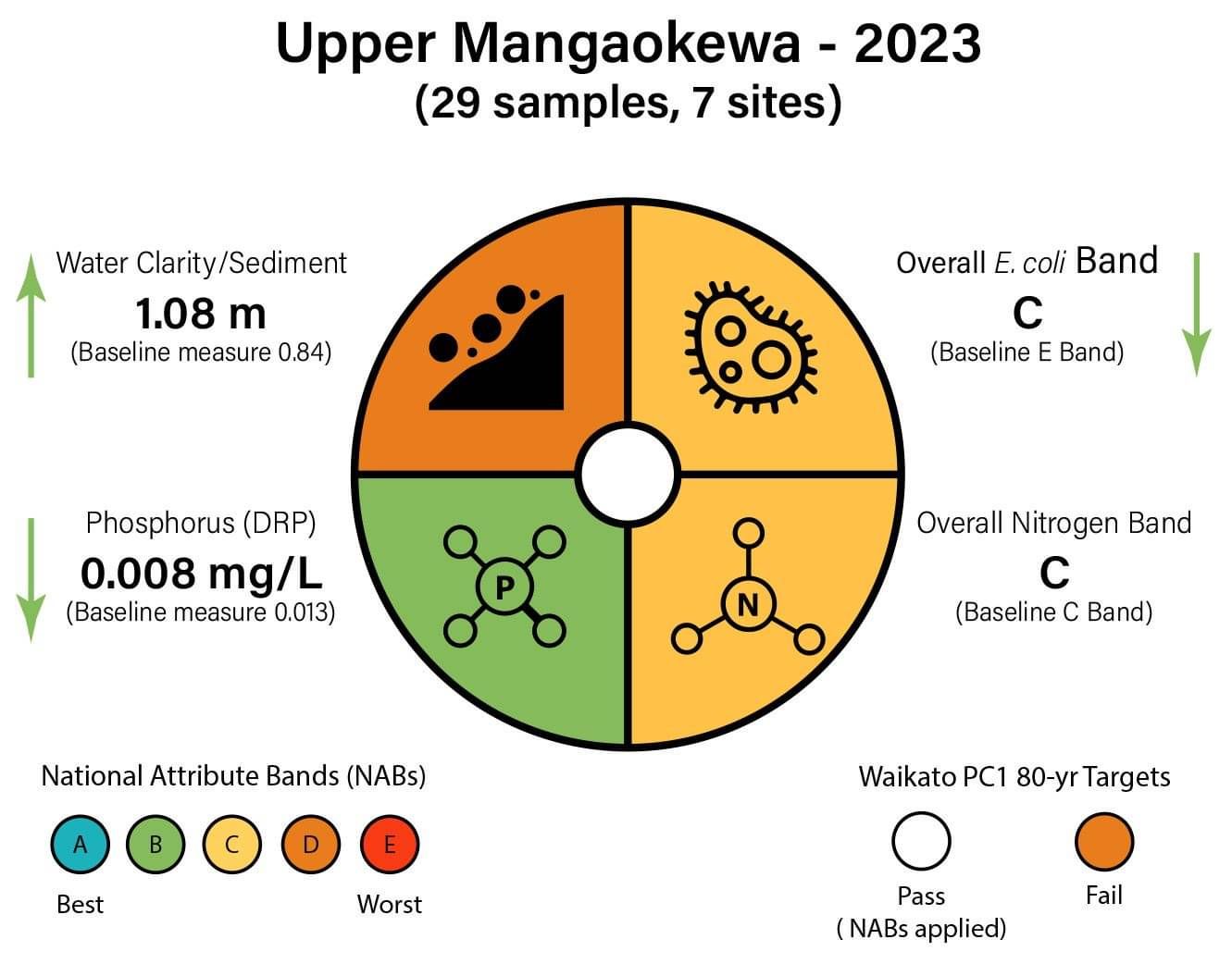
Aquatic Biodiversity Summary
Biodiversity monitoring includes eDNA, collected by KCRC, and traditional biodiversity monitoring techniques (netting of freshwater invertebrates and netting and electrofishing of freshwater fish), by Waikato Regional Council (WRC). eDNA sampling has been done by KCRC, in autumn and winter in 2021, 2022 and 2023. WRC monitors most sites every 1 to 2 years, between November and March. If more than one results is available for any single monitoring location the results for that site are averaged across years.
Upper Mangaokewa
The upper Mangaokewa has high ecological value but shows some signs of stress.
The eDNA site had a high fish score but a low MCI score.
Across the catchment MCI scores were good at 3 out of 5 sites.
Rare native species of fish were detected, including lamprey, longfin eel and torrentfish.
No whitebait species were detected.
Three species of introduced fish detected, mosquito fish, brown trout and rainbow trout.
There is a clear migration pathway for native fish from the sea due to no dams being constructed on the Waipa River or Waikato River, downstream of lake Karapiro.

2023 Quarterly Summaries
November 2023
Water quality was variable between sites, ranging from good to poor due to elevated E. coli, nitrogen and suspended sediment. E. coli concentrations were low at two sites (140) and elevated at two sites (≥ 330). Nitrate concentrations were below toxicity levels at all sites but exceeded regional PC1 targets (0.525 mg/L) at 2 out of 4 sites (between 0.56 – 0.70 mg/L). Nitrate concentrations were lowest at 46-Waiteti Stream-Upper (0.09 mg/L) and highest at 5-Mangawhauwhi Stream (0.70 mg/L). Ammonia concentrations were low at 4-Mangaokewa Stream (viaduct) and exceeded PC1 targets (0.005 mg/L) at 3 out of 4 sites (≥ 0.006 mg/L). Two out of four sites had a dissolved inorganic nitrogen concentration exceeding 0.5 mg/L, potentially impacting river health. Dissolved reactive phosphorus concentrations were low at all sites (≤ 0.009 mg/L). Water clarity was excellent at 4-Mangaokewa Stream (2.25 m) and poor at all other sites (between 1.08 m - 1.24 m), relative to the national bottom line (1.34 m).
Collection date: 14 November 2023

September 2023
Overall, water quality was poor at most sites except for site 46-Waiteti stream-Upper, which had good water quality. Poor water quality was associated with elevated concentrations of E. coli, nitrogen and suspended sediment. E. coli concentrations were very low at 46-Waiteti Stream-Upper (52) and were elevated at all other sites (≥ 280). Nitrate concentrations were below toxicity levels at all sites but exceeded regional PC1 targets (0.525 mg/L) at 3 out of 4 sites (between 0.54 – 0.87 mg/L). Nitrate concentrations were lowest at 46- Waiteti Stream-Upper (0.17 mg/L) and highest at 5-Mangawhauwhi Stream (0.87 mg/L). Ammonia concentrations exceeded PC1 targets (0.005 mg/L) at all sites (between 0.009 – 0.03 mg/L). Ammonia concentrations were lowest at 4-Mangaokewa stream-viaduct and 46-Waiteti stream-upper and highest at 6- Waiteti Stream-viaduct (0.03 mg/L). Three out of four sites had a dissolved inorganic nitrogen concentration exceeding 0.5 mg/L, potentially impacting the health of the river. Dissolved reactive phosphorus concentrations were low at all sites (≤ 0.008 mg/L). Water clarity was poor at all sites (between 0.69 m - 1.47 m), relative to the national bottom line (1.34 m).
Collection date: 12 September 2023

May 2023
E. coli concentrations were low at five sites (≤ 240) and elevated at 6-Waiteti Stream-viaduct (470). Nitrate concentrations were below toxicity levels at all sites but exceeded regional PC1 targets (0.525 mg/L) at 4 out of 6 sites (between 0.53 – 0.93 mg/L). Nitrate concentrations were lowest at 46-Waiteti Stream Upper (0.25 mg/L) and highest at 5-Mangawhauwhi Stream (0.93 mg/L). Ammonia concentrations were exceptionally low at 3 out of 6 sites (≤ 0.005 mg/L) and exceeded PC1 targets (0.005 mg/L) at the other 3 sites being highest at 6-Waiteti Stream-viaduct (0.05 mg/L). Four out of six sites had a dissolved inorganic nitrogen concentration exceeding 0.5 mg/L, potentially impacting the health of the river. Dissolved reactive phosphorus concentrations were low at 3 sites (≤ 0.008 mg/L) and elevated at 3 sites being highest at 4-Mangaokewa Stream (viaduct) and 45-Mangaokewa Stream (0.013 mg/L). Water clarity was poor at all six sites (between 0.56 m - 1.20 m), relative to the national bottom line (1.34 m).
Collection date 8 May 2023.

February 2023
Water Quality Summary 2022
The water quality dial for Upper Mangaokewa combines data collected at 7 monitoring sites between January – December 2022, representing 30 individual samples. Dissolved reactive phosphorus (DRP) was low. E. coli was elevated, while water clarity was low indicating high sediment loading. Nitrate was above the Waikato PC1 target value (0.525 mg/L). Arrows indicate an increase or decrease in values compared to the sub-catchment baseline (2015 – 2020). An increase in water clarity is positive for river health while an increase in all other attributes may impair river health.

